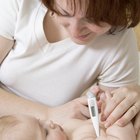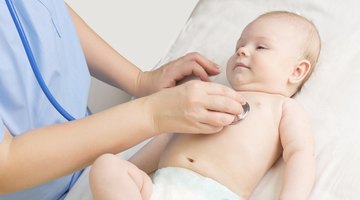Differences Between Taking a Child's Temperature Orally and Under the Arm
When you must take your child’s temperature, you have a couple of options with which to get an accurate reading. You can take your child’s temperature orally by placing the thermometer under the tongue or axillary, by placing it under the arm. Understanding the differences between the two methods will help you ascertain whether your child has a fever.
Oral Temperature
When a child reaches the age of 4 or 5, she is probably ready for you to take her temperature orally, according to the American Academy of Pediatrics HealthyChildren.org website. Wash the thermometer carefully with warm, soapy water and rinse it well. Applying isopropyl alcohol to the thermometer also disinfects it effectively. Tell your child to open her mouth and lift her tongue. With her tongue up, slip the tip of the thermometer under her tongue and have your youngster close her mouth tightly. Sit with your youngster quietly until the thermometer beeps and then read the temperature.
Axillary Temperature

What to Do With an Infant With Skin Hot to the Touch?
Learn More
Taking your child’s temperature under the arm is appropriate from 3 months of age and up, according to the AAP. Turn the thermometer on and place it under your child’s arm so the tip of the thermometer sits at the center point of his armpit, touching only skin and no clothing. Position your youngster’s arm close to his body and hold your child quietly until the thermometer beeps. Remove the thermometer and read the temperature.
Temperature Reading Adjustments
Make an adjustment between an axillary temperature and an oral temperature, advises Cigna Health and Life Insurance Company. Add 1 degree to an axillary temperature to make it equal an oral temperature. For example, if your child’s axillary temperature was 99.1 degrees, add 1 degree to arrive at a temperature equivalent to an oral temperature of 100.1 degrees.
Precautions

The Rules for Taking a Baby's Armpit Temperature
Learn More
The American Academy of Pediatrics cautions parents not to use glass mercury thermometers due to the risk of breakage and potential mercury leaks. Always use a digital thermometer for oral and axillary temperature-taking. Wait a minimum of 15 minutes after your child drinks a warm or cold beverage before taking his oral temperature. A temperature of more than 99.5 degrees orally or 99 degrees axillary confirms a fever, according to KidsHealth. If your child has a fever over 104 degrees repeatedly or if the fever lasts for more than two days in a child under 2 or more than three days for a child over age 2, call your physician, recommends the HealthyChildren.org website.










